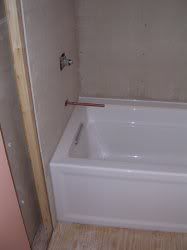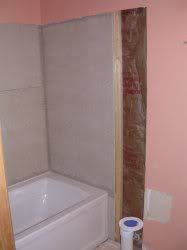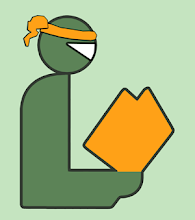We chose Hardiboard over Durock cement board because... um... well, okay, I don't really know. I tuned out after about minute two of the five minute lecture from the guy at Lowes as to its advantages. But we were assured it was fantastic stuff, super easy to work with and would give us no problems at all. And while all of that might be true for some people, namely folks used to working with cement board who know what they're doing and who probably listened to the guy at Lowes better than we did, it was not true for us. This is not to say that we regret using Hardiboard over Durock, just that it wasn't exactly a party.
First off, it took me a long time to get over Hardiboard's texture, which is something akin to the surface of a chalk-board magnified by a power of ten. Simply touching it gave me the heebie jeebies, and I speak as a guy who is entirely comfortable in scraping his fingernails down a chalkboard. Touching Hardiboard was like scraping your hands across silk cloth, in the dead of winter, with no moisturizer, when they're good and rough, only in reverse. (And, let me tell you, after you'd been handling Hardiboard bare-handed for a while, you couldn't touch cloth of any kind.) I wound up wearing work gloves for about half of Saturday until my anger at having limited dexterity in the gloves (and the fact that the fingers of the gloves kept getting pinched between the board and the drywall) overpowered my discomfort and I forced my mind to get over it. After that, I didn't think about it much.
The second major drawback to Hardiboard was that it did not always live up to its billing as far as ease of use. We'd been told all you had to do was score the surface of it and snap it toward the score and you'd get clean lines with no worries. And, to some degree, this is true provided the sections you're snapping apart are both several inches wide. You work with anything smaller than three or four and there's a lot of breaking bits off one at a time with a pair of channel locks. I'm gonna give Hardiboard a pass on this one, considering that I'm the guy who was usually doing the snapping.
The other major drawback to Hardiboard is that it's deadly. It's made of silicate, which is basically sand, but microscopically fine sand held together by cement (or dog spit, for all I know). It's mostly harmless in board form (mostly, cause it is sort of rough and can cut you if you're not careful), but snapping it breaks some of that silicate dust free so that it can be inhaled. If it gets in your lungs, it can eventually cause cancer or pneumonia and so you're really not supposed to do much breathing around it. Furthermore, you're not supposed to sweep it up, cause that just stirs up the dust. So the only way to get rid of it is to vacuum it up (which I'm sure is also inadvisable, since I'm the guy who'll have to change the bag), or soak it up with a damp towel. The whole day, I kept imagining that my lungs were starting to burn and by late afternoon when I was hammer drilling the stuff into the bare flooring of the bathroom, I'd switched to a respirator.
 Of course, as with nearly every step of our project so far, each part of this weekend's work took far longer than we'd hoped and revealed problems we'd not expected that we had to solve before we could move on, such as having to carve out even MORE drywall in order to toe in some new semi-studs that could support both the Hardiboard and drywall we'll eventually put there.
Of course, as with nearly every step of our project so far, each part of this weekend's work took far longer than we'd hoped and revealed problems we'd not expected that we had to solve before we could move on, such as having to carve out even MORE drywall in order to toe in some new semi-studs that could support both the Hardiboard and drywall we'll eventually put there.We also wound up smashing some valuables, of both the actual and sentimental varieties, we'd been storing on some display shelves attached to the other side of one of the walls. One of the items was an antique milk jar, the kind the milk man might leave on a doorstep, filled with even older antique marbles that had belonged to my grandfather. The marbles are fine, but the milk jar wound up vibrating off the edge of its shelf due to our hammer drilling on the other side, fell and smashed.
 Our major problem, though, wound up being the position of the plumbing valve, as well as the pipes attached to it. It was not set far enough back within the wall to allow the new metal shower lever to sit flush against the backplate, as we preferred, so we wound up having to remove an entire section of Hardiboard in order to make adjustments. And even then, we had to calculate and recalculate the anticipated thickness of not only the tile we'll eventually install, but the mastic and gold coat that would sit between it and the Hardiboard, too. Kind of hard to do when you don't have the tile on hand to measure.
Our major problem, though, wound up being the position of the plumbing valve, as well as the pipes attached to it. It was not set far enough back within the wall to allow the new metal shower lever to sit flush against the backplate, as we preferred, so we wound up having to remove an entire section of Hardiboard in order to make adjustments. And even then, we had to calculate and recalculate the anticipated thickness of not only the tile we'll eventually install, but the mastic and gold coat that would sit between it and the Hardiboard, too. Kind of hard to do when you don't have the tile on hand to measure.Fortunately, we've already ordered the tile, it's on the way and should be to us by the weekend. In the meantime, I get to Goldcoat waterproof the new walls in anticipation of the mastic and tile to come.
(TO BE CONTINUED...)



No comments:
Post a Comment